SpartanNash Bundle
Who Buys Groceries from SpartanNash?
Navigating the complex world of retail requires a deep understanding of the consumer. For SpartanNash, grasping its SpartanNash SWOT Analysis is crucial for success. Understanding the company's customer base, including their demographics and preferences, is key to strategic planning. This analysis dives deep into the evolving landscape of the retail market and the strategies SpartanNash employs to stay ahead.
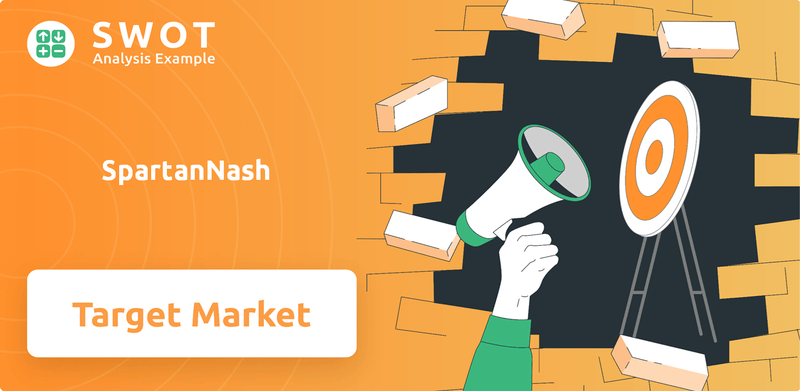
This exploration of the SpartanNash customer profile and SpartanNash target market will provide valuable insights for investors, business strategists, and anyone interested in the retail market analysis. We'll examine customer demographics, shopping habits, and how SpartanNash adapts to meet the changing needs of its diverse customer base. From grocery store customers to military personnel, discover how SpartanNash strategically positions itself to thrive in a competitive environment, considering factors like consumer behavior SpartanNash and geographical operations.
Who Are SpartanNash’s Main Customers?
Understanding the customer demographics and target market of SpartanNash is crucial for grasping its business model. The company serves a diverse range of customers across its Food Distribution, Retail, and Military segments. Each segment caters to distinct needs and preferences, shaping SpartanNash's operational strategies and market approach.
The company's ability to adapt to changing market demands and consumer behaviors is evident in its investments in supply chain capabilities and its varied retail banners. This adaptability allows SpartanNash to effectively serve its diverse customer base. A detailed look into each segment reveals how SpartanNash tailors its offerings to meet specific customer requirements.
The company's strategic focus, as discussed in the Competitors Landscape of SpartanNash, includes understanding and serving its primary customer segments effectively.
This segment primarily serves businesses (B2B), including independent grocery retailers and national accounts. These customers seek efficient supply chain solutions, a broad assortment of grocery products, and competitive pricing. This segment's focus is on providing wholesale distribution services, ensuring products reach retailers efficiently.
The Retail segment directly serves consumers (B2C) through its owned and operated grocery stores. The demographics of these grocery store customers vary by location but generally include households seeking convenient access to fresh produce, pantry staples, and specialty items. The stores are designed to cater to local preferences and needs.
This segment also operates on a B2B basis, specifically serving military commissaries and exchanges. It provides grocery products to service members and their families, requiring adherence to specific government contracts and logistical expertise. This segment highlights SpartanNash's ability to manage complex supply chains.
While specific demographic breakdowns are not publicly detailed, the Food Distribution and Military segments likely represent significant revenue shares due to their large-scale operational nature. SpartanNash's target market segmentation reflects its strategic approach to different customer groups.
SpartanNash's ability to effectively serve its diverse customer base is critical to its success. Understanding the needs and preferences of each segment allows the company to tailor its offerings and strategies. This includes adapting to changing market demands and consumer behaviors, as well as maintaining efficient supply chain operations.
- Adaptability: The company must remain flexible to meet the evolving needs of its diverse customer base.
- Efficiency: Maintaining efficient supply chain operations is essential for both the Food Distribution and Military segments.
- Customer Focus: Tailoring offerings to meet the specific needs of grocery store customers and military families.
- Market Analysis: Continuous retail market analysis and understanding of consumer behavior SpartanNash are important for strategic decisions.
SpartanNash SWOT Analysis
- Complete SWOT Breakdown
- Fully Customizable
- Editable in Excel & Word
- Professional Formatting
- Investor-Ready Format
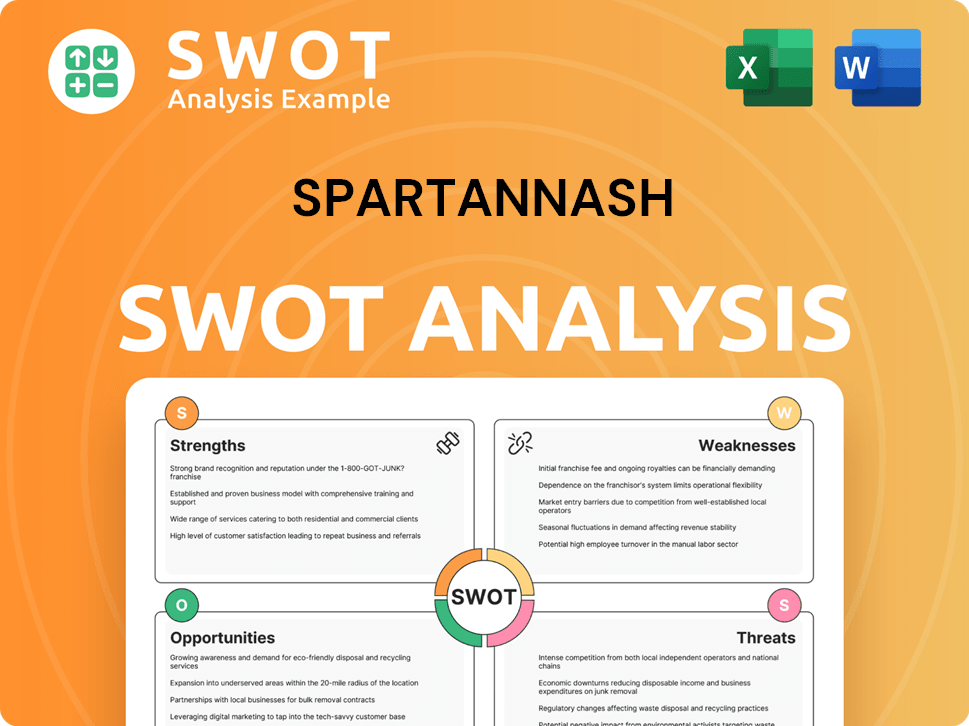
What Do SpartanNash’s Customers Want?
Understanding the customer needs and preferences is crucial for the success of any business, and for SpartanNash, this understanding is particularly important given its diverse customer base. The company serves various segments, each with unique demands and expectations. This detailed analysis helps in tailoring offerings and strategies to meet the specific needs of each group, enhancing customer satisfaction and loyalty.
The customer demographics and target market of SpartanNash are multifaceted, encompassing both B2B and B2C clients. The company's ability to adapt to these varied needs is a key factor in its market performance. By focusing on these distinct segments, SpartanNash can optimize its operations and marketing efforts, ensuring it remains competitive and relevant in the grocery and distribution sectors. This approach allows SpartanNash to cater to a wide range of consumers and business partners effectively.
The customer profile of SpartanNash includes a wide array of individuals and businesses. This diversity requires a nuanced approach to understanding their needs. From independent retailers to military commissaries, each segment has unique requirements that SpartanNash must address. This targeted approach helps SpartanNash to maintain and grow its market share.
For B2B customers in food distribution, reliability and efficiency are paramount. Independent retailers and national accounts rely on SpartanNash for consistent product availability and timely deliveries. These customers often prioritize cost-effectiveness and logistical support.
B2C customers in the retail segment value convenience, quality, and value. Factors such as store location, product freshness, and competitive pricing influence purchasing decisions. Personalized promotions and a pleasant shopping environment drive loyalty.
The military segment prioritizes adherence to strict guidelines, consistent product quality, and efficient delivery. SpartanNash supports military personnel and their families by addressing supply chain issues and tailoring offerings to meet specific needs.
Across all segments, SpartanNash addresses common pain points through its robust distribution network. The company tailors its offerings, such as fresh produce programs and specialized logistics, to meet specific segment requirements.
SpartanNash has emphasized initiatives like 'Our Family' brand products, catering to value-conscious consumers in its retail stores. This focus on value helps attract and retain customers looking for affordable options.
SpartanNash operates geographically, primarily in the United States, with a strong presence in the Midwest and other regions. This strategic positioning enables it to serve a wide range of customers effectively.
To better understand the company's performance, it's important to look at the Owners & Shareholders of SpartanNash. By focusing on these diverse segments, SpartanNash can optimize its operations and marketing efforts, ensuring it remains competitive and relevant in the grocery and distribution sectors. This approach allows SpartanNash to cater to a wide range of consumers and business partners effectively.
A deeper dive into each segment reveals specific preferences and needs that SpartanNash addresses through its products and services. Understanding these nuances is crucial for strategic planning and customer satisfaction.
- Food Distribution: Independent retailers and national accounts require a wide product assortment, competitive pricing, and reliable delivery schedules. SpartanNash provides these through its extensive distribution network and private label offerings.
- Retail: Grocery store customers seek convenience, quality, and value. Factors such as store location, product freshness, and competitive pricing influence purchasing decisions. The company's loyalty programs and promotions are designed to enhance the shopping experience.
- Military: The military segment demands adherence to strict operational guidelines, consistent product quality, and efficient delivery to support military personnel and their families. SpartanNash's specialized logistics and supply chain solutions are tailored to meet these specific needs.
- Consumer Behavior: Understanding consumer behavior is key. For example, shoppers are increasingly looking for healthier options, which influences product selection. Also, the rise of online grocery shopping impacts how SpartanNash serves its customers.
SpartanNash PESTLE Analysis
- Covers All 6 PESTLE Categories
- No Research Needed – Save Hours of Work
- Built by Experts, Trusted by Consultants
- Instant Download, Ready to Use
- 100% Editable, Fully Customizable
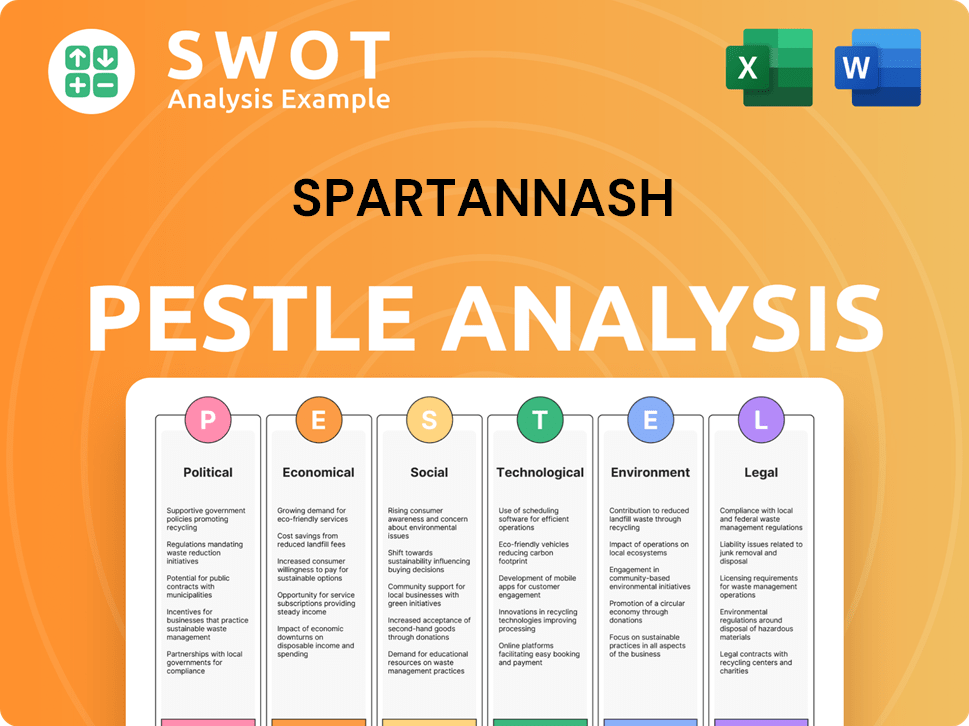
Where does SpartanNash operate?
The geographical market presence of SpartanNash is primarily centered within the United States. The company strategically operates across numerous states, with a strong focus on the Midwest region. This includes both retail operations and extensive food distribution networks, alongside its significant presence in the military segment.
SpartanNash's retail segment has a significant footprint in states like Michigan, Indiana, and Ohio, where it has established strong brand recognition. The food distribution segment extends its reach nationally, serving independent retailers and national accounts. Furthermore, the military segment has a national and international presence, supplying grocery products to U.S. military commissaries and exchanges worldwide.
Understanding the nuances of customer demographics, preferences, and buying power across these diverse regions is crucial for SpartanNash. The company adapts its product assortments and marketing strategies to cater to local tastes and demographic profiles. For a deeper understanding of the company's origins and evolution, explore the Brief History of SpartanNash.
SpartanNash's retail operations are concentrated in the Midwest, specifically in states like Michigan, Indiana, and Ohio. These locations benefit from strong brand recognition and a loyal customer base. The company tailors its offerings to meet the specific needs and preferences of the local communities.
The food distribution segment has a broader reach, serving independent retailers and national accounts across the U.S. This segment relies on a robust distribution network to ensure efficient delivery and meet diverse customer needs. It supports a wide array of grocery store customers.
SpartanNash is a leading distributor to U.S. military commissaries and exchanges globally. This segment has a national and international presence, providing essential grocery products to military personnel and their families. This segment is a key part of the SpartanNash customer profile.
SpartanNash continuously evaluates its geographic distribution of sales and growth opportunities. The company strategically expands or optimizes its operations to maximize market share and profitability. This includes adapting to shifts in consumer behavior SpartanNash observes.
SpartanNash's geographic strategy focuses on several key elements to ensure success in its target market. These include:
- Customer Demographics: Analyzing and understanding customer demographics is essential for tailoring product offerings and marketing strategies. This helps in defining who are SpartanNash's typical customers.
- Local Preferences: Adapting to regional tastes and preferences is crucial for building customer loyalty.
- Supply Chain Efficiency: A robust supply chain infrastructure is vital for serving diverse markets efficiently.
- Market Analysis: Continuous evaluation of market trends and opportunities is necessary for strategic expansion.
- Competitive Landscape: Understanding the competitive environment in each region helps in making informed decisions.
SpartanNash Business Model Canvas
- Complete 9-Block Business Model Canvas
- Effortlessly Communicate Your Business Strategy
- Investor-Ready BMC Format
- 100% Editable and Customizable
- Clear and Structured Layout
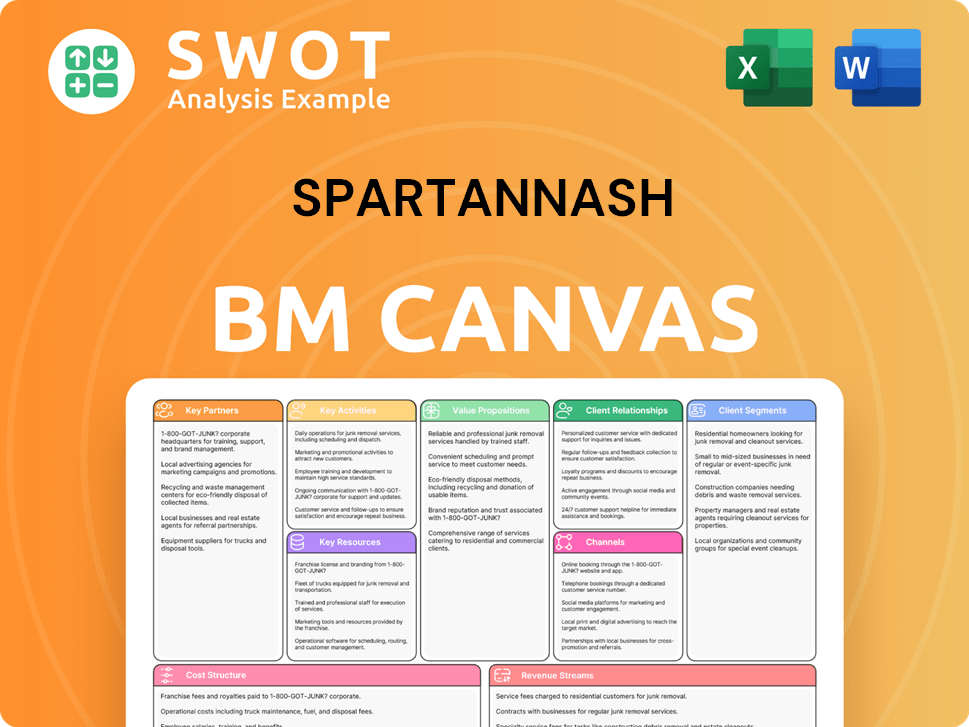
How Does SpartanNash Win & Keep Customers?
Customer acquisition and retention are critical strategies for the success of any company, and for the [Company Name], this involves a multi-faceted approach tailored to its diverse business segments. Understanding the customer demographics and preferences is key to implementing effective strategies. It focuses on building strong relationships with its clients, providing value, and adapting to the changing needs of the market.
The company employs different tactics for its B2B food distribution, retail, and military segments. The B2B segment focuses on direct sales and maintaining strong account management. The retail segment uses a mix of marketing strategies, including loyalty programs and in-store experiences. The military segment relies on competitive bidding processes and high performance to retain contracts.
By leveraging customer data and CRM systems, the company aims to segment its customer base. This approach allows for targeted marketing campaigns and the continuous improvement of customer satisfaction. The goal is to improve customer lifetime value across all segments.
Acquisition in the B2B food distribution segment relies heavily on direct sales and building relationships with retailers. It focuses on showcasing its reliable supply chain management. Competitive pricing is also a key factor to attract new clients.
Retention in the B2B segment is driven by strong account management and consistent service levels. Adapting to evolving retailer needs, such as offering private label products and merchandising support, is also crucial. The company strives to maintain long-term partnerships.
In the Retail segment, a mix of traditional and digital marketing channels is used for customer acquisition. This includes local advertising, weekly circulars, and social media promotions. In-store promotions are also used.
Customer retention in the Retail segment is strongly supported by loyalty programs. The 'yes' loyalty program offers personalized discounts and rewards. Enhancing the in-store experience with fresh offerings is also a focus.
For the Military segment, acquisition relies on competitive bidding processes. The company emphasizes logistical efficiency and product quality. Winning government contracts is a key aspect.
Retention in the Military segment involves maintaining high performance standards. This includes fulfilling government contracts and ensuring product quality. The focus is on reliability and efficiency.
The company utilizes customer data and CRM systems. This allows for segmenting the customer base. It also enables the tailoring of marketing campaigns for relevance.
- Customer data analysis helps understand customer demographics, preferences, and needs.
- CRM systems support personalized marketing and targeted promotions.
- Continuous feedback mechanisms are used to improve customer satisfaction.
- Strategic initiatives are implemented to increase customer lifetime value.
For example, in 2024, the company's focus on private label brands and merchandising support for its B2B clients and promotional offers in the retail segment, as highlighted in the Marketing Strategy of SpartanNash, shows a commitment to customer needs and market trends. This proactive approach to customer acquisition and retention, supported by data-driven strategies and tailored marketing campaigns, positions the company for continued success in a competitive market.
SpartanNash Porter's Five Forces Analysis
- Covers All 5 Competitive Forces in Detail
- Structured for Consultants, Students, and Founders
- 100% Editable in Microsoft Word & Excel
- Instant Digital Download – Use Immediately
- Compatible with Mac & PC – Fully Unlocked
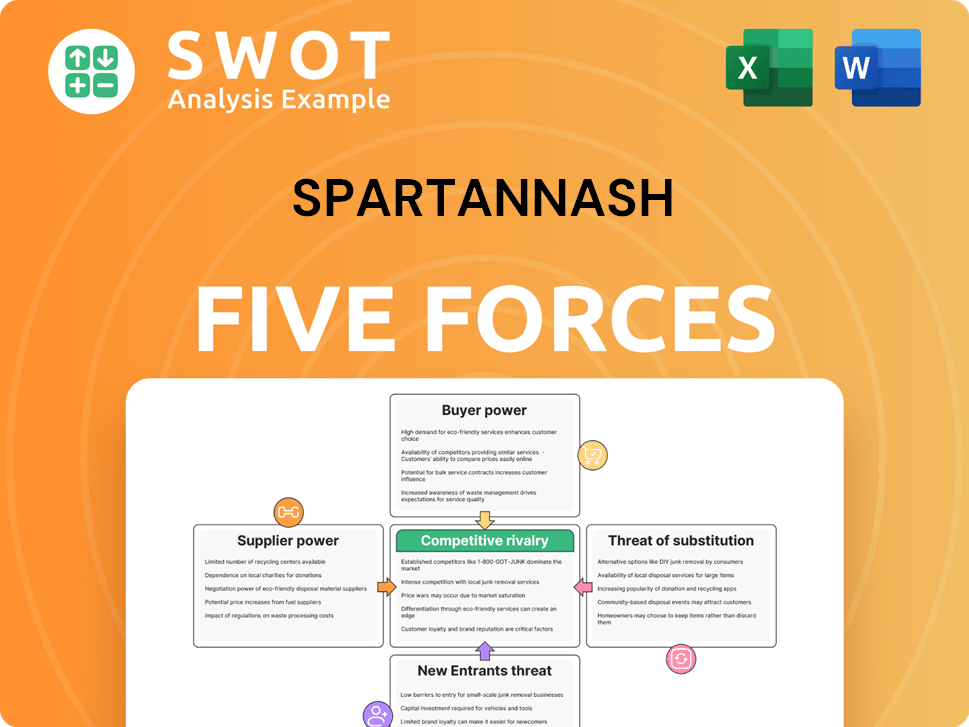
Related Blogs
- What are Mission Vision & Core Values of SpartanNash Company?
- What is Competitive Landscape of SpartanNash Company?
- What is Growth Strategy and Future Prospects of SpartanNash Company?
- How Does SpartanNash Company Work?
- What is Sales and Marketing Strategy of SpartanNash Company?
- What is Brief History of SpartanNash Company?
- Who Owns SpartanNash Company?
Disclaimer
All information, articles, and product details provided on this website are for general informational and educational purposes only. We do not claim any ownership over, nor do we intend to infringe upon, any trademarks, copyrights, logos, brand names, or other intellectual property mentioned or depicted on this site. Such intellectual property remains the property of its respective owners, and any references here are made solely for identification or informational purposes, without implying any affiliation, endorsement, or partnership.
We make no representations or warranties, express or implied, regarding the accuracy, completeness, or suitability of any content or products presented. Nothing on this website should be construed as legal, tax, investment, financial, medical, or other professional advice. In addition, no part of this site—including articles or product references—constitutes a solicitation, recommendation, endorsement, advertisement, or offer to buy or sell any securities, franchises, or other financial instruments, particularly in jurisdictions where such activity would be unlawful.
All content is of a general nature and may not address the specific circumstances of any individual or entity. It is not a substitute for professional advice or services. Any actions you take based on the information provided here are strictly at your own risk. You accept full responsibility for any decisions or outcomes arising from your use of this website and agree to release us from any liability in connection with your use of, or reliance upon, the content or products found herein.